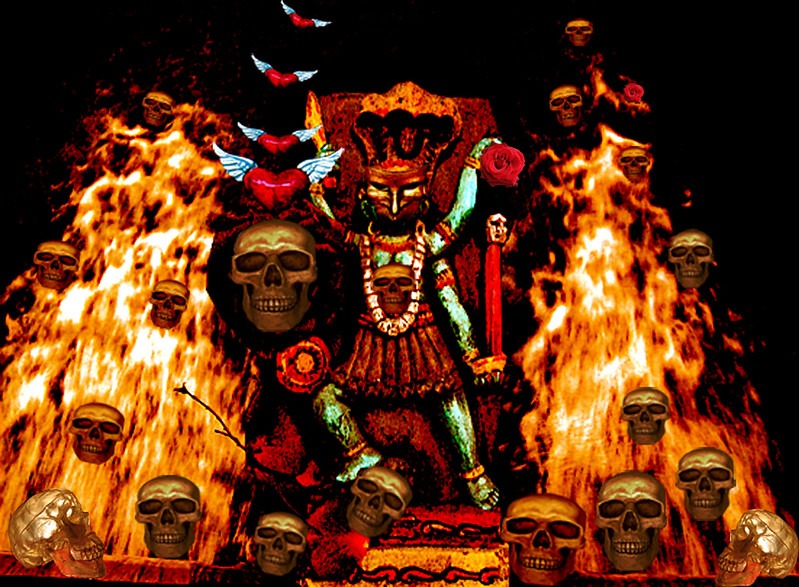A Tale of Self-Discovery
. . .
I heard of Kali before I saw her image. “Kali is the goddess of divine transformation,” boomed my yoga philosophy teacher.
We’d been studying all the gods and goddesses of the Hindu pantheon, but this lesson caused me to sit up straighter on the yoga shala’s cement floor. Kali was no sober-minded goddess of art and music (Sarasvati), or fertility (Lakshmi), or, heavens forefend, devotion (Parvati). This lady was something else entirely.
“Legend has it that the warrior Kali was born when all the other gods combined their shakti [divine energy] to create one superior being who could destroy the evil demon Raktabija.”
According to my teacher, the gods had long been in a battle of good and evil. Thus far, the demon Raktabija had been impossible to defeat because each time his blood fell to the ground, his clone would sprout on the spot. To defeat this enemy, Kali fought his warrior clones with her four arms, using her fierce tongue to lap up every drop of his blood before it touched the earth. When at last there was only one Raktabija left, she beheaded him and drank his blood.
My immediate thought was, Perfect! I will worship her.
“Beware of following Kali,” came the next words from my teacher’s mouth. “She will destroy your life.”

Far from putting me off, I was compelled. I desperately wanted my life to change. I was in India on a yoga teacher training course. I’d landed there in the wake of my divorce, not because I imagined becoming a yoga teacher. I was 40. “A bit long in the tooth,” as my mother said, to style myself as a physical fitness leader. Mostly I wanted a time out, a break between my old life as a married woman with a corporate career wondering how she’d start a family to my new one as a post-menopausal divorcee.
And yes. You read that right. Though forty is extremely early to be post-menopausal, this recent trauma fueled my frenzy for Kali. That and the fact that my other half had called from eight time zones away to announce he wanted a divorce. My fear was that if I didn’t eradicate the flaw that made him run away from me, I’d be blindsided by love again. I reckoned that someone like Kali — considered a harsh master, or at the very least, symbolic of tough love — could do the job.
At the internet café in Anjuna Beach, I looked the warrior goddess up online. The images I found intrigued. Sometimes blue-skinned, sometimes black, Kali is typically shown mouth agape, her long curling tongue extended and her fangs dripping blood. Her hair is wild and matted. She wears the severed arms of her enemies as a skirt, and a necklace of their skulls. Her left arms hold her weapons, while in her right arms she holds Raktabija’s head and a platter to catch his blood. Often she’s shown standing atop Shiva, representing her threat to the entire universe.

As I began to collect icons of Kali — being in India made this easier than you might suspect — I imagined offering her all my woes. Shame, doubt, unlovability. I pictured her lapping up these demons with abandon. But, like my teacher had warned, there was something she wanted in return.
After setting up residence in New York City, where I soon became a yoga teacher, I began to see that I’d built many relationships on the same sandy ground where I’d laid my marriage. Alarmingly often, I paired up with friends and lovers I felt were better than me — just as I’d considered my smarter, kinder and better-looking husband — hoping I might improve by osmosis. This view of the world served no one.
With the clarity of Kali killing demons in battle, I saw that if I was going to have healthier relationships, I needed to do a lot of letting go. When I did, it was with claw marks.
Another aspect of Kali — typically depicted in an endless dance atop the prone Shiva — is her powerful sexual energy. I can’t say that she was the cause, but as I continued to surround myself with images of Kali as inspiration and sing the Kali Durga chant — Om Sri Maha Kalikayai Namaha, a request for liberation — I began to view the early menopause as a wonder. Freed from the possibility that I would have a child or could even be expected to, I lost all sense of urgency around dating. I was able to focus on building relationships first.
Blissful Thinking: A Memoir of Overcoming the Wellness Revolution is my forthcoming book about what I learned on the road to healing. I still have Kali’s image everywhere. “I have one right next to me on a lunchbox,” I enthuse.
Yet, when I set about writing this piece, I pulled the tin box from the shelf and discovered that no, the goddess I’d kept was not Kali, but Durga (in some legends, considered the mother of Kali). Durga, though also associated with destruction, is seen as the protective mother of the universe.
And this was the greatest lesson of all, one that told me I’d moved on from a life that needed to be burned to the ground. Claw marks no longer required.
This is an excerpt from Blissful Thinking:
A Memoir of Overcoming the Wellness Revolution.
A book launch event at Tombolo Books
in St. Pete will be held September 26 at 7 pm.
Bill DeYoung of the St. Pete Catalyst
will lead a conversation with the author.
You can find the details here.





